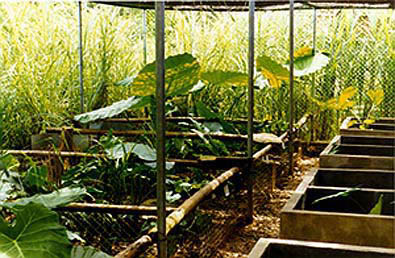There are four types:
- Terrestrial Enclosures range from 3 x 5 meters (smallest) to 10 x 5 meters. They include habitat for Cuora galbinifrons, Indotestudo elongata, Manouria impressa, and Pyxidea mouhotii. Some are in open field areas with banana trees and other natural vegetation as cover. Others are set back into the scrubby hillside with bamboo thickets, trees, and edge and forest vegetation. Numbers within an enclosure range from four to eight, depending on enclosure size. Recently, we have separated males and females in preparation for spring.
- Semi-aquatic Enclosures are the same as terrestrial enclosures with concrete pools, which range from 3 x 5 to 4 x 8 meters. Habitat includes scrub, forest, and open (planted) areas. Species include Cyclemys tcheponensis, Cuora galbinifrons, Pyxidea mouhotii, and Manouria impressa.
- Semi-aquatic Large Pools are similar sized enclosures with deep pools. All are located in the quarantine section. One is located in our “secure cage” (a cage housing a number of semi-aquatic enclosures and aquatic tanks that was built after the theft of Mauremys annamensis in June 99). Species are Platysternon megacephalum (the happy campers in the old facility we dare not move), Heosemys grandis, and Hieremys annandalei.
- Aquatic Tanks are 2 m x 70 cm concrete tanks with a small terrestrial section at one end. Each houses about two turtles; species include Sacalia quadriocellata, Ocadia sinensis, Mauremys annamensis, Siebenrockiella crassicollis, Cuora amboinensis, Platysternon megacephalum, Pelodiscus sinensis, Hieremys annandalei, Malayemys subtrijuga, and Geoemyda spengleri. Eight are built in the secure cage, and eight more have just been completed outside. The Project also has four large concrete aquatic tanks for larger turtles, which house Heosemys grandis, Hieremys annandalei, Mauremys annamensis, and Cyclemys tcheponensis (pulchristiata).
Health
Each turtle received in from the trade is inspected, data sheet completed, and photographed (plastron and carapace with ID number card). In the past we wormed all new additions; however, this practice has since stopped, limiting worming to health cases and Manouria. Antibiotics are administered by a trained veterinarian to those that show signs of problems. Turtles are then quarantined for two months in isolation from the main body of residents (now across the street). Losses account for about 5% during the first 60 days. After that, very few are lost. Exceptions include Manouria impressa, a traditionally difficult species, and Malayemys subtrijuga, which almost always die.
Feeding
Some species (e.g., Indotestudo elongata and Cuora galbinifrons) are fed a nutritional mix of vegetables, forest plants, tofu, and fruits three times a week. However, diets vary considerably with species. Aquatics and other species that do not “feed from the plate” receive worms, grasshoppers, aquatic snails, terrestrial snails, mushrooms, cut fish, crabs, and aquatic vegetation. Normal feeding is three times weekly for all species, usually in the early morning. However, all turtles also receive supplemental feeding on the odd days of the week. These include many of the items listed above. For example, local villagers bring in a kilo of earthworms daily, as well as grasshoppers, water hyacinth (a favorite of Heosemys and Hieremys), Elodea sp., aquatic snails, and other items listed above.
Pyxidea mouhotii devour large African land snails, an introduced “pest” species, which locals collect for us from around their village. We maintain “feed bins” of most of the primary and supplemental foods and stock them regularly. Species are fed as much of their natural diet as possible, with considerable variation. The only prepared food is the “mix” described above. Of course, not all turtles receive this (e.g., Malayemys eat aquatic snails almost exclusively).






|
